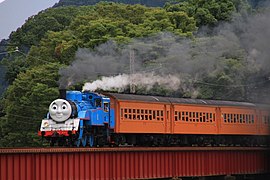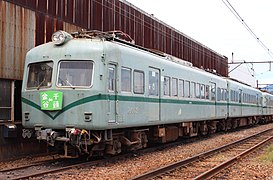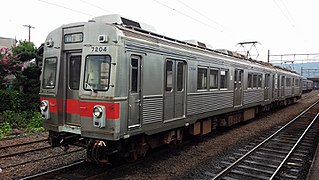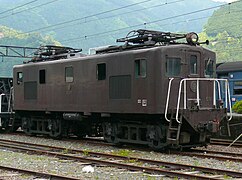Ōigawa main line
| Ōigawa main line | |||||||||||||||||||||||||||||||||||||||||||||||||||||||||||||||||||||||||||||||||||||||||||||||||||||||||||||||||||||||||||||||||||||||||||||||||||||||||||||||||||||||||||||||||||||||||
|---|---|---|---|---|---|---|---|---|---|---|---|---|---|---|---|---|---|---|---|---|---|---|---|---|---|---|---|---|---|---|---|---|---|---|---|---|---|---|---|---|---|---|---|---|---|---|---|---|---|---|---|---|---|---|---|---|---|---|---|---|---|---|---|---|---|---|---|---|---|---|---|---|---|---|---|---|---|---|---|---|---|---|---|---|---|---|---|---|---|---|---|---|---|---|---|---|---|---|---|---|---|---|---|---|---|---|---|---|---|---|---|---|---|---|---|---|---|---|---|---|---|---|---|---|---|---|---|---|---|---|---|---|---|---|---|---|---|---|---|---|---|---|---|---|---|---|---|---|---|---|---|---|---|---|---|---|---|---|---|---|---|---|---|---|---|---|---|---|---|---|---|---|---|---|---|---|---|---|---|---|---|---|---|---|---|
|
Bridge over the Ōi
| |||||||||||||||||||||||||||||||||||||||||||||||||||||||||||||||||||||||||||||||||||||||||||||||||||||||||||||||||||||||||||||||||||||||||||||||||||||||||||||||||||||||||||||||||||||||||
| Route length: | 39.5 km | ||||||||||||||||||||||||||||||||||||||||||||||||||||||||||||||||||||||||||||||||||||||||||||||||||||||||||||||||||||||||||||||||||||||||||||||||||||||||||||||||||||||||||||||||||||||||
| Gauge : | 1067 mm ( cape track ) | ||||||||||||||||||||||||||||||||||||||||||||||||||||||||||||||||||||||||||||||||||||||||||||||||||||||||||||||||||||||||||||||||||||||||||||||||||||||||||||||||||||||||||||||||||||||||
| Power system : | 1500 V = | ||||||||||||||||||||||||||||||||||||||||||||||||||||||||||||||||||||||||||||||||||||||||||||||||||||||||||||||||||||||||||||||||||||||||||||||||||||||||||||||||||||||||||||||||||||||||
| Maximum slope : | 22.0 ‰ | ||||||||||||||||||||||||||||||||||||||||||||||||||||||||||||||||||||||||||||||||||||||||||||||||||||||||||||||||||||||||||||||||||||||||||||||||||||||||||||||||||||||||||||||||||||||||
| Minimum radius : | 200 m | ||||||||||||||||||||||||||||||||||||||||||||||||||||||||||||||||||||||||||||||||||||||||||||||||||||||||||||||||||||||||||||||||||||||||||||||||||||||||||||||||||||||||||||||||||||||||
| Top speed: | 65 km / h | ||||||||||||||||||||||||||||||||||||||||||||||||||||||||||||||||||||||||||||||||||||||||||||||||||||||||||||||||||||||||||||||||||||||||||||||||||||||||||||||||||||||||||||||||||||||||
| Dual track : | No | ||||||||||||||||||||||||||||||||||||||||||||||||||||||||||||||||||||||||||||||||||||||||||||||||||||||||||||||||||||||||||||||||||||||||||||||||||||||||||||||||||||||||||||||||||||||||
| Society: | Ōigawa Tetsudō | ||||||||||||||||||||||||||||||||||||||||||||||||||||||||||||||||||||||||||||||||||||||||||||||||||||||||||||||||||||||||||||||||||||||||||||||||||||||||||||||||||||||||||||||||||||||||
|
|||||||||||||||||||||||||||||||||||||||||||||||||||||||||||||||||||||||||||||||||||||||||||||||||||||||||||||||||||||||||||||||||||||||||||||||||||||||||||||||||||||||||||||||||||||||||
The Ōigawa main line ( Japanese 大 井 川 本 線 , Ōigawa-honsen ) is a railway line on the Japanese island of Honshū , which is operated by the railway company Ōigawa Tetsudō (also called Daitetsu). It opens up the central part of the Ōi Valley in Shizuoka Prefecture . Originally built as a feeder to the construction sites of various dams and hydroelectric power stations, it is now of particular importance for tourist excursion traffic. The Ōigawa Main Line is Japan's only railway line that offers special trips with historic vehicles all year round .
description
The Ōigawa main line laid in Cape Gauge (1067 mm) is 39.5 km long and electrified with 1500 V direct current . It serves 19 train stations and stops, and the maximum speed is 65 km / h. Train crossings at eight intermediate stations are possible on the single-track route. From Kanaya station , the line initially runs about a kilometer eastwards, parallel to the Tōkaidō main line , and then turns in a wide arc to the north. The operational focus is the subsequent Shin-Kanaya station with attached depot and museum. The tunnel-rich route then leads through mountainous terrain along the Ōi and crosses this river a total of four times. It ends in Senzu , where the parking facility is located and you can change to the Ikawa line .
business
In regional transport , nine pairs of trains run daily from Kanaya to Senzu and back. Electric railcars are used for this purpose . Other trains run from Kanaya to the next Shin-Kanaya station. These establish a connection to the special trains with historical vehicles that go from there to Senzu and back. On the way, they only stop at Ieyama and Shimoizumi stations. A seat reservation is required for the special trains, which run one to three times a day all year round.
No other railway line in Japan has such a well-developed range of nostalgic trips, which is why the Ōigawa main line is a popular travel destination for railway enthusiasts and photographers. In fact, the railway company generates 90% of its turnover with such offers. To more families with young children to gain as customers, one of the operational steam locomotives in the style of the main character of the popular children's book series in Japan "since 2014 Thomas & Friends " ( Engl. Thomas the Tank Engine ) decorated.
Due to the nostalgic flair and the charming landscape, the Ōigawa main line, the trains running on it and several train stations often serve as a backdrop for film and television productions - especially if the action is set in the prewar period.
vehicles
Over the decades, Daitetsu acquired numerous historic steam locomotives , electric locomotives , railcars and passenger cars in order to either keep them in working order or to exhibit them in their museum at Shin-Kanaya station.
Steam locomotives
- The oldest steam locomotive owned by the Daitetsu is No. 8 of the C10 series, built by Kawasaki Sharyō in 1930 . It was last used in Aizu-Wakamatsu in 1961 and has been operating on the Ōigawa main line since 1997. The 12.65 m long locomotive weighs 69.7 tons and is the only surviving example of this series.
- The Daitetsu has two copies of the C11 series, also manufactured by Kawasaki Sharyō. They are 12.65 long, weigh 66.05 tons and can go up to 85 km / h. While No. 190, built in 1940, came to Daitetsu in 2001, No. 227, built three years later, formed the basis for the vehicle collection in 1975.
- No. 44 of the C56 series, built by Mitsubishi in 1936 , was first used on Hokkaidō , later in Thailand during the Pacific War . Remaining undamaged, it was returned to Japan in 1979. The locomotive is 14.325 m long and weighs 37.63 tons, the associated end Tender 27.9 tons.
- Currently (2019) out of service is No. 164 of the C12 series, built in 1937 by Nippon Sharyō . Their length is 11.35 m, their weight 50.0 tons.
Multiple units
- For non-tourist regional traffic, Daitetsu usually uses three electric multiple units of the 16000 series, consisting of a permanently coupled multiple unit and a non-motorized control car . Made in 1965 by Kinki Sharyō , they were used on the Kintetsu rail network in the Osaka region and have been on the Ōigawa main line since 1998. One car is 20.5 m long, with the railcar weighing 42 tons and the control car weighing 34 tons.
- The two multiple units of the 21000 series consist of two permanently coupled multiple units with a length of 17.725 and a weight of 37 tons. They were created in 1958 at Teikoku Sharyō for the railway company Nankai Denki Tetsudō, which operates south of Osaka .
- A class 7200 multiple unit is also composed of two firmly coupled multiple units. The Tōkyū Dentetsu built them in their own company for use in the Tokyo area . From 2000 owned by Towada Kankō Dentetsu , the 17 m long car came to Daitetsu twelve years later.
- At the moment (2019) out of service is the multiple unit of the class 3000, which is composed of one multiple unit and one control car. Manufactured in 1971 by Kawasaki Sharyō for the Keihan Denki Tetsudō railway company , it was used as an express train between Osaka and Kyoto . Each 18.7 m long, the railcar weighs 35 tons and the control car 34 tons.
Electric locomotives
- The E10 series is represented with copies (No. 1 and 2). Mitsubishi Electric manufactured both for Daitetsu in 1949 to pull freight trains on the just electrified Ōigawa main line. Today they are used for shunting tasks. They are 12.8 m long and weigh 48 tons.
- ED500 is a Hitachi locomotive manufactured in 1956 and has been with Daitetsu since 2000. It was used at a cement factory in Ibuki , as well as in the construction of Chūbu airport . The length is 12.64 m, the weight 50 tons.
Passenger cars
The Daitetsu owns around twenty passenger cars from the early Shōwa period , most of which were once in service with the Japanese State Railways and belong to types 35 and 47. There are also several freight cars.
history
In earlier times, the inhabitants of the sparsely populated central part of the Ōi Valley had to rely on horses or boats to transport goods. On March 10, 1925, the Ōigawa Tetsudō railway company was founded . However, local traffic needs were of secondary importance when the Ōigawa main line was built. Above all, the transport of workers and material to the construction sites of several dams and hydroelectric power stations of the electricity company Ōigawa Denki (today Chūbu Denryoku ) should be facilitated.
The first section from Kanaya to Yokooka was opened on June 10, 1927. On December 1, 1929, we went to Ieyama. Further sections were added in quick succession: Ieyama – Jina on July 16, 1930, Jina – Shiogō on September 23, 1930, Shiogō – Shimoizumi on February 1, 1931, Shimoizumi – Aobe on April 12, 1931 and finally Aobe – Senzu on September 1 , 1931 December 1931. While at the beginning only trains operated by steam locomotives were added from October 1930 onwards by diesel locomotives . The short branch line to the first terminus Yokooka was closed on December 2, 1931.
A few years after the end of the Pacific War , numerous new hydropower projects were to be carried out on Ōi. Since the transport capacity would not be sufficient for this, the Daitetsu carried out the electrification of the railway line, which was completed on November 18, 1949. It initially introduced railcars for passenger transport, and from August 1951 electric locomotives were also used for freight transport. The management recognized early on that the importance of passenger and freight transport would decrease. That is why Daitetsu began on July 9, 1976, as the first Japanese railway company to carry out special trips with historic vehicles. Freight traffic ended on October 1, 1983.
List of train stations
| Surname | km | Connecting lines | location | place |
|---|---|---|---|---|
| Kanaya ( 金谷 ) | 0.0 | Main Tōkaidō line | Coord. | Shimada |
| Shin Kanaya ( 新 金谷 ) | 2.3 | Coord. | ||
| Daikanchō ( 代 官 町 ) | 3.8 | Coord. | ||
| Higiri ( 日 切 ) | 4.3 | Coord. | ||
| Goka ( 五 和 ) | 5.0 | Coord. | ||
| Kamio ( 神 尾 ) | 9.8 | Coord. | ||
| Fukuyō ( 福 用 ) | 12.3 | Coord. | ||
| Owada ( 大 和田 ) | 14.8 | Coord. | ||
| Ieyama ( 家山 ) | 17.1 | Coord. | ||
| Nukuri ( 抜 里 ) | 18.8 | Coord. | ||
| Kawaneonsen Sasamado ( 川 根 温泉 笹 間 渡 ) | 20.0 | Coord. | ||
| Jina ( 地名 ) | 22.9 | Coord. | Kawanehon | |
| Shiogō ( 塩 郷 ) | 24.3 | Coord. | ||
| Shimoizumi ( 下 泉 ) | 27.4 | Coord. | ||
| Tanokuchi ( 田野 口 ) | 31.0 | Coord. | ||
| Suruga-Tokuyama ( 駿 河 徳 山 ) | 34.1 | Coord. | ||
| Aobe ( 青 部 ) | 36.1 | Coord. | ||
| Sakidaira ( 崎 平 ) | 37.2 | Coord. | ||
| Senzu ( 千頭 ) | 39.5 | Ikawa line | Coord. |
Web links
- Website of Ōigawa Tetsudō (English)
Individual evidence
- ↑ Timetable. Ōigawa Tetsudō, 2019, accessed February 5, 2019 .
- ↑ 大 井 川 鉄 道 「地 元 と 協 働」. Chūnichi Shimbun , September 1, 2015, archived from the original on September 23, 2015 ; Retrieved February 5, 2019 (Japanese).
- ^ Thomas the Tank Engine. Ōigawa Tetsudō, 2019, accessed February 5, 2019 .
- ↑ Vicki L. Beyer: Shizuoka's Oi River Valley - lots to explore. Japan Today, March 25, 2016, accessed February 5, 2019 .
- ↑ Shizuoka City Sightseeing Guidebook. (PDF, 1.2 MB) pp. 9–10 , accessed on February 5, 2019 (English).
- ^ Dai-Tetsu train guide. Ōigawa Tetsudō, 2019, accessed February 5, 2019 .
- ↑ C10 Model 8. Ōigawa Tetsudō, 2019, accessed on February 5, 2019 (English).
- ↑ C11 Model 190. Ōigawa Tetsudō, 2019, accessed on February 5, 2019 (English).
- ↑ C11 Model 227. Ōigawa Tetsudō, 2019, accessed on February 5, 2019 (English).
- ↑ C56 Model 44. Ōigawa Tetsudō, 2019, accessed on February 5, 2019 (English).
- ↑ C12 Model 164. Ōigawa Tetsudō, 2019, accessed on February 5, 2019 (English).
- ^ Train 16000 Series. Ōigawa Tetsudō, 2019, accessed February 5, 2019 .
- ↑ Train 21000 Series. Ōigawa Tetsudō, 2019, accessed February 5, 2019 .
- ↑ Train 7200 Series. Ōigawa Tetsudō, 2019, accessed February 5, 2019 .
- ↑ Train 3000 Series. Ōigawa Tetsudō, 2019, accessed February 5, 2019 .
- ^ Electric Locomotive E10. Ōigawa Tetsudō, 2019, accessed February 5, 2019 .
- ↑ Electric Locomotive ED500. Ōigawa Tetsudō, 2019, accessed February 5, 2019 .
- ^ The story behind the railway ... its history. Ōigawa Tetsudō, accessed February 5, 2019 .
- ↑ 地方 鉄 道 及 軌道 一 覧: 附 ・ 専 用 鉄 道. 昭和 10 年 4 月 1 日 現在. National Parliamentary Library , April 1, 1954, accessed February 5, 2019 (Japanese).
- ^ Company profile. Ōigawa Tetsudō, accessed February 5, 2019 .














